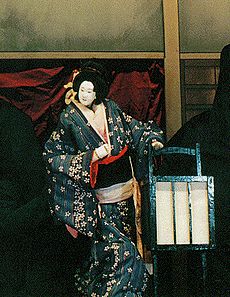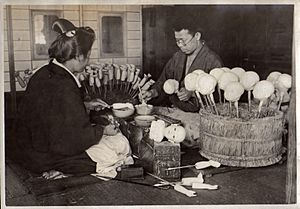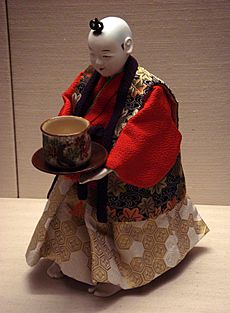Japanese dolls facts for kids
Japanese dolls (called ningyō in Japanese, meaning "human form") are a special part of Japanese crafts. They are not just toys; they are traditional art pieces.
There are many kinds of Japanese dolls. Some look like children or babies. Others show people from the imperial court, brave warriors, or characters from fairy tales and myths. You can also find dolls that show everyday people from Japanese cities. Many of these dolls have a long history. They are still made today for homes, as gifts, or for special events. These events include Hinamatsuri (the Doll Festival) and Kodomo no Hi (Children's Day). Some dolls are made as local crafts. People buy them as souvenirs when they visit temples or travel.
The History of Japanese Dolls
Dolls have been made in Japan for a very long time. Ancient Japanese cultures, like the Jōmon (8000–200 BC), made human-like figures called dogū. Later, the Kofun culture (around 300–600 AD) made Haniwa figures for tombs. These might be early forms of Japanese dolls.
Records show that grass dolls were blessed and thrown into a river at Ise Shrine in 3 BC. This old custom is likely the start of the modern Doll Festival, Hinamatsuri.
By the early 11th century, during the Heian period, different types of dolls were already known. This is mentioned in The Tale of Genji, a famous Japanese novel. Girls played with dolls and dollhouses. Women made dolls to protect their children. Dolls were also used in religious events. People believed dolls could take away their sins.
Hōko dolls were soft dolls given to young women. They were especially given to pregnant women. These dolls were meant to protect both the mother and her unborn baby. They became more common in the Muromachi period.
Okiagari-koboshi are roly-poly toys made from papier-mâché. They have been around since at least the 14th century. These dolls are considered good-luck charms. They represent being strong and never giving up.
The first professional dollmakers were probably temple sculptors. They used their skills to create painted wooden dolls of children. They used a special white lacquer called gofun, made from ground oystershells and glue. This allowed for very detailed and beautiful dolls.
During the Edo period (1603–1867), Japan was mostly closed off from other countries. This led to a boom in doll-making. Wealthy people bought beautiful and expensive doll sets. These sets became larger and more detailed. The government eventually set rules for dollmakers. This was to control the materials and size of the dolls.
Types of Japanese Dolls
Most traditional Japanese dolls developed during the Edo period.

- Hina Dolls: These are the dolls for Hinamatsuri, the Doll Festival on March 3. Classic hina dolls have a pyramid-shaped body. They are made with many layers of cloth, stuffed with straw or wood. Their hands and heads are often made of carved wood. They are covered with gofun (white lacquer). Early dolls had painted eyes, but later ones had glass eyes. A full set has at least 15 dolls. They represent specific characters with many tiny accessories. The most basic set is a male and female pair, often called the Emperor and Empress.
- Kintarō Dolls: These dolls are given to Japanese children during the Tango no Sekku holiday. They are meant to inspire bravery and strength. This is because they represent the legendary child hero, Kintarō.
- Musha Dolls: Also known as warrior dolls, these are similar to hina dolls. But they are often more complex. They show men or women sitting, standing, or riding horses. Their armor, helmets, and weapons are made from lacquered paper, often with metal details. There isn't a fixed set of these dolls. They can show figures like Emperor Jimmu, Empress Jingū, or fairy-tale heroes like Momotarō (the Peach Boy).
- Gosho Dolls: These dolls show cute, chubby babies in a simple form. The basic gosho is a nearly naked sitting boy, carved from one piece of wood. They have very white skin. Later, gosho dolls with fancy clothes and hairstyles became popular. They were often given as gifts linked to the Imperial court. "Gosho" means "palace" or "court."
- Kimekomi Dolls: These dolls are made of wood. They started as Kamo dolls, small dolls carved from willow wood. They were decorated with fabric scraps. Kimekomi is a method of making dolls. It starts with a carved wood base. Grooves are cut into the base. Then, different patterned cloth pieces are glued on. The edges of the cloth are tucked into the grooves. The head and hands are usually finished with gofun. These dolls are a popular craft today.
- Karakuri Ningyō: These are mechanical puppets or dolls. They include large figures used on festival floats, like those at Kyoto's Gion Matsuri. Smaller ones are used for entertainment, often with music and movement. They often show legendary heroes.

- Bunraku Puppets: These are special puppets used in a traditional Japanese theater style. Bunraku theater was a rival to Kabuki theater. It is still performed today.

- Kokeshi Dolls: These wooden dolls have been made for about 150 years. They come from Northern Honshū, Japan's main island. They were first made as toys for farmers' children. They have no arms or legs, but a large head and a cylinder-shaped body. They represent little girls. Now, they are a famous Japanese craft and a popular souvenir for tourists.
- Iki-ningyō: These are life-sized, very realistic dolls. They were popular in misemono (sideshow) performances. Artists made iki-ningyō that were new and sometimes shocking. For example, some showed figures lying in pools of blood. These dolls helped create a very realistic style in Japanese doll-making.
- Ichimatsu Dolls: These dolls represent little girls or boys. They have correct body proportions, flesh-colored skin, and glass eyes. The first Ichimatsu dolls were named after an 18th-century Kabuki actor. They likely looked like adult men. But since the late 1800s, the name has been used for child dolls. These dolls are usually made to be held, dressed, and posed. In 1927, 58 large Ichimatsu dolls were sent from Japan to the United States as a gift. These "friendship dolls" influenced dollmakers to create more solemn, gentle-looking girl dolls in beautiful kimonos.
- Daruma Dolls: These are round dolls with red bodies and white faces, but no pupils in their eyes. They represent Bodhidharma, who founded Zen Buddhism about 1500 years ago. Legend says he removed his eyelids to stay awake during meditation. His limbs also withered from long meditation. Daruma dolls are good-luck charms. They bring good fortune and help people achieve their goals. You usually buy them without eyes. You fill in one eye when you make a wish. You fill in the other eye when your wish comes true. People often do this on New Year's Day.
- Teru Teru Bozu: This is not strictly a doll. It is handmade from white paper or cloth. People hang it from a window by a string. It is believed to bring good weather and stop the rain.
- Hoko Dolls: These soft dolls are given to young women, especially pregnant ones. They act as a talisman to protect both the mother and her unborn child.
After the Edo period ended and the modern Meiji era began in the late 1800s, doll-making changed again.
- Silk-skinned Dolls: These dolls, also called "mask-face" dolls, became popular in the 1920s and 1930s. People could design detailed kimonos for dolls that looked like women from different times in Japanese history. These dolls were popular souvenirs for soldiers and tourists after World War II.
- Bisque Dolls: These dolls are made of fired clay. Fukuoka is a traditional center for making bisque dolls. Hakata ningyō are famous throughout Japan.
- Anesama Ningyō and Shiori Ningyō: These dolls are made of washi paper. Anesama ningyō are usually three-dimensional. Shiori ningyō are flat, like bookmarks. Anesama ningyō often have fancy hairstyles and costumes made from high-quality washi paper. They usually don't have facial features. Dolls from Shimane Prefecture are especially well-known.
- Shikishi Ningyō: This is a newer type of Japanese paper doll. They are a mix of anesama ningyō and shiori ningyō. Shikishi ningyō show figures and scenes. They are mounted on a shikishi, which is a rectangular piece of fancy cardboard.
- Ball-Jointed Dolls (BJDs): These are more modern Japanese dolls. They became very popular in the US and other countries after the Super Dollfie was first made by Volks in 1999. BJDs can look very realistic or be inspired by the anime style. They are made of strong polyurethane resin. Owners can customize these dolls a lot. They can sand them, change their wigs and eye colors, and even change their face paint. This hands-on part makes them popular with both collectors and hobbyists.
Collecting Japanese Dolls
Japanese dolls can be grouped into several types for collectors. Two main types are hina-ningyo (Girl's Day dolls) and musha-ningyo (Boy's Day warrior dolls). Other types include display dolls like sagu-ningyo, gosho-ningyo, and isho-ningyo. Collections can also be sorted by the material they are made from. For example, there are wood dolls like kamo-ningyo and nara-ningyo. There are also clay dolls like Fushimi ningyo, Koga ningyo, and Hakata ningyō.
In the 1800s, ningyō were introduced to Western countries. Since then, doll collecting has become a popular hobby there. Famous Western collectors include James Tissot and Jules Adeline. James Tissot was a religious history painter. He became interested in Japanese art in 1862. He was one of the most important collectors of Japanese art in Paris. His collection included kosode-style kimonos, paintings, and many bijin-ningyo (dolls from the late Edo period). Jules Adeline was an artist. He was known for his etchings. He collected many ningyō dolls.
During the Meiji period, three men were pioneers in collecting ningyō in Japan. They were Shimizu Seifū, Nishizawa Senko, and Tsuboi Shōgorō. They are known as "Gangu San Ketsu" (the three great toy collectors). They started collecting ningyō in a careful way. This was to save and record the different types of dolls. Shimizu, an artist, made an illustrated catalog of his 440 ningyō dolls. It was published in 1891. Nishizawa, a banker, collected many hina-ningyo. He also researched stories and information about hina-ningyo from the Edo period. Tsuboi, a scientist, brought a scientific approach to collecting dolls.
Dolls have been a big part of Japanese Culture for many years. Collecting them is still a popular activity. Many doll collections are kept in museums. These include the Peabody Essex Museum and the Kyoto National Museum.
|
See also
 In Spanish: Muñeco tradicional japonés para niños
In Spanish: Muñeco tradicional japonés para niños




